5 Major Ports in Poland
Poland is a central European country and one of the largest economies in the European Union, possessing a strong financial and services sector, employing 60 per cent of the population. It has a stable industrial base resting on coal extraction, machinery, iron and steel, electronics, automobiles, fertilisers and petrochemicals.
The Polish economy has proven to be one of the most resilient in the region despite facing the first GDP contraction since 1991. It has a highly developed commercial shipping sector handling the majority of its foreign trade.
Poland’s coastline extends from Baltic Sea Coast along the Pomerania Bay in the west and the Gulf of Gdansk in the east. The 770 km long coastline is dotted with major seaports, while smaller port facilities are located on the estuaries of the Vistula, Oder and Warta rivers.
In this article, let us explore the 5 major seaports of Poland.
1. Port of Gdansk
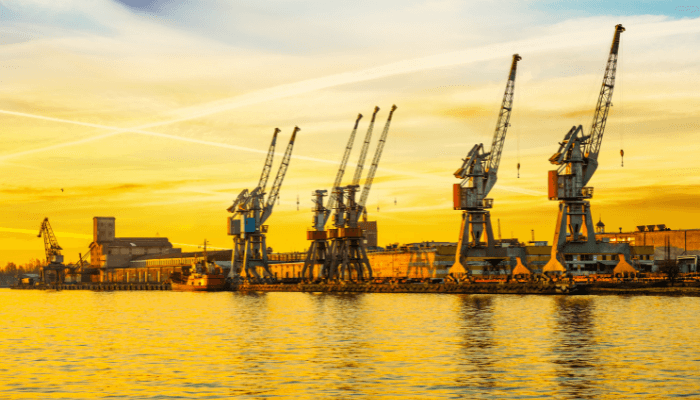
Gdansk port is located at the mouth of Motlawa River on the southern coast of Gdansk Bay and is one of the largest seaports on the Baltic Sea. Poland’s busiest port handled 53.2 million tonnes of cargo, 2,092,432 TEUs and 164,000 passengers in 2021.
An industrial section situated near the port premises houses shipbuilders, food processing units and high-tech industries like electronics, IT engineering, telecommunications and pharmaceuticals. A significant proportion of the world’s amber deposits are found along the Baltic coastline, hence processing this beautiful natural resin is another major source of income for local industries.
Port Layout
Due to its extensive size and varied terrain, the port is segregated into two operational areas; the inner port consisting of the Dead Vistula and the port channel and the outer port lying near Gdansk Bay.
The outer harbour has deepwater terminals that can admit the biggest ships sailing through the Danish Straits, with an LOA of 400 m and a 15 m draft. Regular shipping lines include the Baltic region and the North Sea States, the Americas and Asian Countries.
Container loads dominate regular transport; however, automobile, conventional cargo, Roro and liquid bulk also comprise a substantial part of the transport market.
Port Terminals
An added advantage of the Gdansk port is its customisable quays to suit the requirements of the customers. It has more than 7 specialised terminals handling grains, Roro, coal, LPG, ores and fertilisers.
Container Terminal
The Gdansk container terminal covers 88 hectares and has a storage area for keeping 64,000 TEUs. It has a 1300 m berthing line and is the only facility in the Baltic Sea capable of handling container ships carrying 24,000 TEUs. A second deepwater quay was built in 2016, making it the biggest terminal in the region in terms of reloading operations. It also has 8300 m2 of container yards and 1072 reefer connections.
It became operational in 2007 and has direct connections to the biggest ports like Shanghai, and Hong Kong and feeder services to Russian and German ports.
Liquid Terminal
It consists of 4 wharves that handle crude oil, diesel, and heating oil. An intricate system of pipelines delivers fuels to refineries and handling stations in Poland and eastern Germany. Fully automated, the terminal is imbued with high-tech closed-receiving technology and fire and spill protection systems.
Ferry terminal
Spanning 72,000 m2, the passenger and ferry terminal is situated on the Obrońców Westerplatte dock, close to the port entrance. It is linked with the Gdansk-Warsaw route and handles Roro, ferries and passenger ships arriving from Sweden. It has three berths for serving 225 m long vessels and two floating pontoons.
2. Port of Gdynia
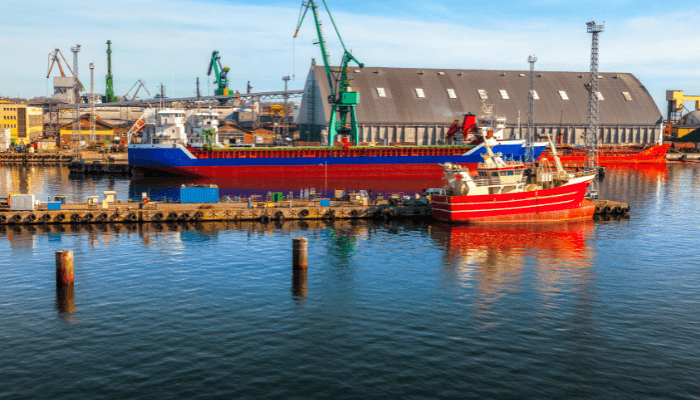
A modern facility in the Baltic Sea region, the Gdynia Harbour lies in northern Poland on the northwestern coast of Gdansk Bay. The largest seaport of the country, it is also the home port for the Polish navy. An artificial port, it is protected by breakwaters, does not witness tidal variations and remains ice-free throughout the year.
All types of cargo pass-through this facility including general cargo, dry goods, liquid bulk and containers. Major commodities handled comprise grains, coal, automobiles, iron ore, sugar, lumber and food products. Around 27 million tonnes of cargo and 4 million TEUs were handled in 2020, recording an 11.3 per cent growth from the previous year.
Port Layout
Gdynia port covers 973 hectares of area, out of which 300 hectares are dedicated to port operations, storage facilities and parking lots. It has more than 20 wharves with a total quay length of 17,700 m and average depths ranging between 7 to 17 m.
Container terminal
The Baltic Container Terminal handles around 2 to 4 million TEUs annually. Operated by Hutchison Ports, the facility covers around 20 hectares and has an 812 m long wharf.
Modernisation works began at the terminal in 2020 for building an additional container berth covering 400 m. Dredging operations were also undertaken for increasing the alongside depths to 16 m for accommodating the largest container ships.
Presently, it has 2 super-post-Panamax ship-to-shore gantry cranes with 65-ton lifting capacity, 7 electric rubber-tired gantry cranes and 15 reach stackers.
Liquid Bulk Terminal
This facility exports ammonium nitrate and receives shipments of fuel oils. Its three wharves can receive ships with a 200 m LOA and a 10.8 m draft. It also has 5 fuel tanks for storing liquid fuels.
Bulk Terminal
It comprises 6 berths that specialise in handling ammonium sulphate, fertiliser imports and transshipments. It contains 4 port silos and an automatic conveyor belt system aiding in loading and unloading operations.
General Cargo Terminal
This terminal consists of 9 docks and an area dedicated for Roro transshipments equipped with modern ramps, 26,000 m2 of warehouse space, sheds for keeping 126 trailers and a container storage area spanning 7500 m2.
The conventional berths handle steel products, bagged cargoes like rice, coffee, cocoa and heavy cargoes like granite blocks. 4 warehouses at the Francuskie wharf are used for storing perishable items like exotic fruits.
Grain Terminal
Gydnia grain terminal handles around 50% of Poland’s sea-borne grain shipments. Opened in 1937, it exports grains and cereal transshipments originating from the Danube states. Today, it is the biggest grain facility in the country.
3. Port of Szczecin
Szczecin is located at the mouth of the River Odra, just 65 km from the open sea. It is connected to Berlin by roadways and Europe’s highway network. It is the closest to
Slovakia, Czech Republic and is the shortest route connecting Sweden with Central Europe. It also links Russia and Finland with Western European countries. An important part of Europe’s inland waterways, it is a famous river cruise destination.
Given its strategic location, it handles varieties of goods and bulk cargo such as coal, coke, grain, iron ore, scrap iron, timber, cement, salt, sugar and containers. Also, Ro-Ro trailers and finished products like paper, wood pulp, steel, and liquid bulk comprising chemicals and tar are handled.
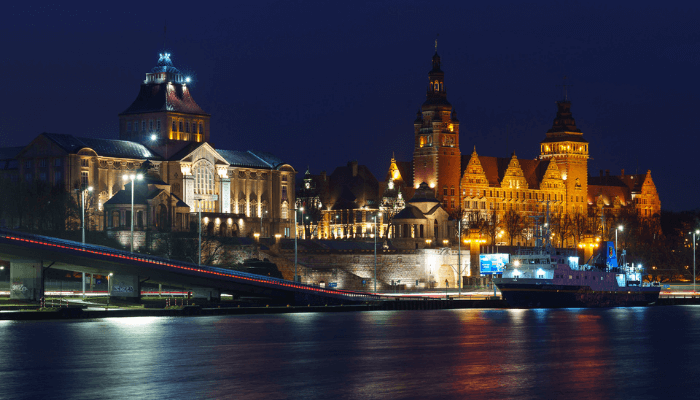
Major trade partners include the Scandinavian countries, Germany, the UK, China and West African nations. Around 7500 cargo ships, 19,250,000 tonnes of cargo, 42,000 TEUs and 60,000 passengers are handled annually.
Port Specifications and Specialised Terminals
This port has wharves totalling 20 kilometres in length and a 15,000 m2 storage area for keeping 800 TEUs of containerised cargo. The port’s container terminal can handle around 50,000 TEUs every year. A newly constructed 14,700 m2 cold storage area can accommodate around 420 reefer containers.
Szczecin Coal Terminal can load and discharge around 1000 tonnes of coal in 60 minutes and is equipped with 5 cranes with a 16-ton lifting capacity. It has a receiving area for storing 200,000 tonnes of coal.
The grain terminal has three wharves and boasts the biggest grain silo in Poland with a total capacity of 80,000 m3 of grains. A passenger terminal is also situated near the port entrance serving ferries, river barges and small fishing vessels.
The port also houses a duty-free zone covering 20 hectares. It has five berths with a total quay length of 1377 m capable of accommodating 10,000 DWT vessels with a maximum draft of 8 m. A 60,000 m2 storage area and three storehouses measuring 26,000 m2 adjacent to the logistics building are used for keeping aluminium, cacao beans and granite blocks imported from Africa.
4. Port of Świnoujście
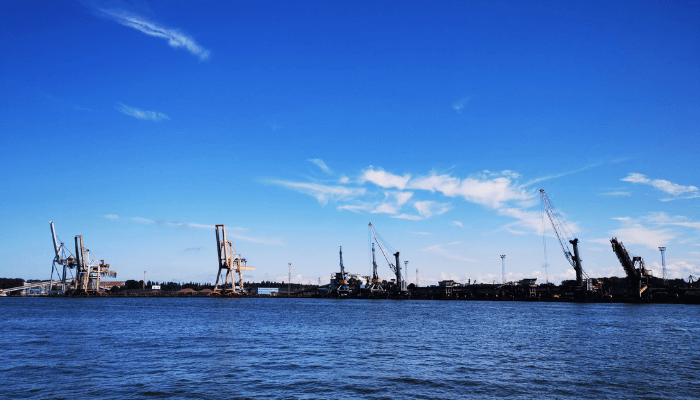
Lying on the eastern shores of Uznam island at the mouth of the Swina river on the southern Baltic coast, Port Handlowy Świnoujście is an important fishing port and a resort. It is also the biggest dry bulk terminal in Poland handling coal, iron ore, and fertilisers. Over 3000 ships pass through this port every year. In 2021, it handled 33.2 million tonnes of cargo, recording a phenomenal 8.2 per cent growth.
Its access channel spans 32 nautical miles and is 14 m deep and 200 m wide. It is connected to the hinterland through railways and inland waterways. It has 10 wharves with an alongside depth of 12.8 m and several terminals.
Port terminals
The coal terminal accommodates bulk carriers weighing 30,000 to 65,000 DWT, loading 30,000 tonnes every 24 hours. It also has a de-freezing point and belt conveyor system.
It has an iron ore terminal consisting of 2 berths for receiving iron ore shipments. Liquid Bulk is dealt with at the Chemikow Quay comprising a new 3600 m3 tank and pipeline for transferring liquid tar pitch.
General cargo, aggregates and ores are handled at the Hutnikow Quay. Endowed with three grab cranes, it has a 5000 m2 warehouse for general cargo and 31,000 m2 open storage yards.
The Wladyslawa Wharf is utilised for lighterage and the port’s ferry terminal provides passenger, train and ferry services to Copenhagen, Denmark and Sweden.
5. Port of Kolobrzeg
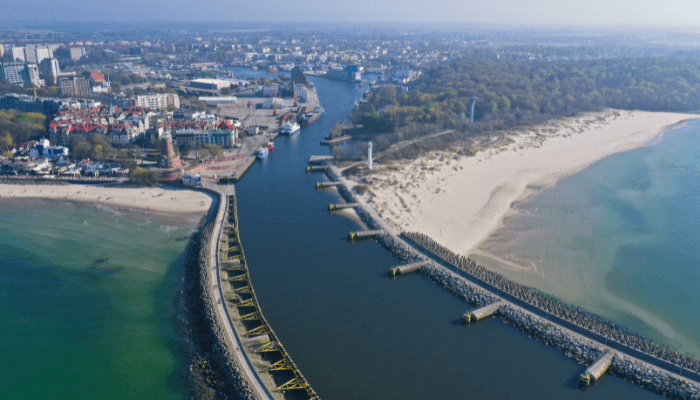
One of the biggest commercial ports of the country, Kolobrzeg is situated on the eastern bank of the River Parseta before it flows into the Baltic Sea. It has an 84 m broad entrance channel protected by two slightly curved breakwaters. Vessels with a maximum LOA of 100 m and a draught of 5 m can enter the inner harbour which is divided into two operational areas.
The commercial activities are concentrated on the eastern side whereas the fishing wharves are located in the western part of Kolobrzeg port. More than 1000 vessels, 120,000 tonnes of cargo and 45,000 passengers are handled at the facility every year.
Today, Kolobrzeg is a flourishing trade town and a therapy resort providing natural treatments for respiratory, metabolic and other bodily ailments.
Port Specifications
It has 9 wharves with a total quay length of 2500 m and alongside depths of 6 m. Its specialised berths are well-equipped to handle dry bulk cargo, grains, foodstuff, timber and general cargo. The town’s economy rests on fishing, agriculture and small-scale manufacturing. Previously, herring trade was an additional source of income for the native community.
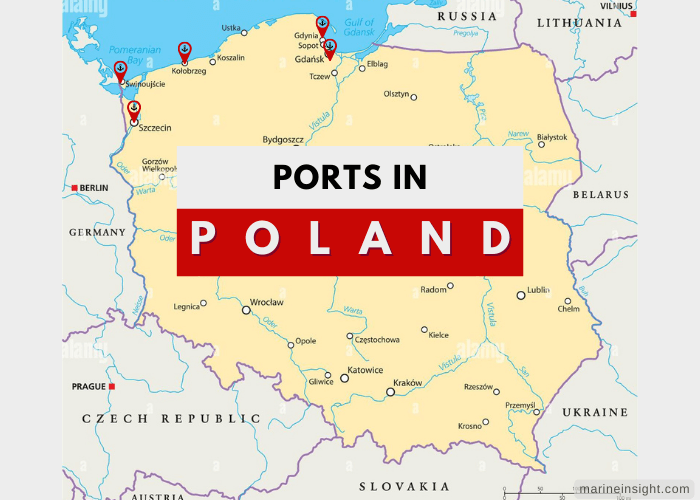
You might also like to read:
- 7 Major Ports in Saudi Arabia
- 5 Major Ports in South Korea
- 6 Major Ports in South America
- 7 Major Ports and Harbours in Bulgaria
- 8 Major Ports in Australia
Disclaimer :
The information contained in this website is for general information purposes only. While we endeavour to keep the information up to date and correct, we make no representations or warranties of any kind, express or implied, about the completeness, accuracy, reliability, suitability or availability with respect to the website or the information, products, services, or related graphics contained on the website for any purpose. Any reliance you place on such information is therefore strictly at your own risk.
In no event will we be liable for any loss or damage including without limitation, indirect or consequential loss or damage, or any loss or damage whatsoever arising from loss of data or profits arising out of, or in connection with, the use of this website.
Do you have info to share with us ? Suggest a correction
Disclaimer :
The information contained in this website is for general information purposes only. While we endeavour to keep the information up to date and correct, we make no representations or warranties of any kind, express or implied, about the completeness, accuracy, reliability, suitability or availability with respect to the website or the information, products, services, or related graphics contained on the website for any purpose. Any reliance you place on such information is therefore strictly at your own risk.
In no event will we be liable for any loss or damage including without limitation, indirect or consequential loss or damage, or any loss or damage whatsoever arising from loss of data or profits arising out of, or in connection with, the use of this website.

About Author
Shilavadra Bhattacharjee is a shipbroker with a background in commercial operations after having sailed onboard as a Third Officer. His interests primarily lie in the energy sector, books and travelling.
Latest Maritime Knowledge Articles You Would Like:
Subscribe To Our Newsletters
By subscribing, you agree to our Privacy Policy and may receive occasional deal communications; you can unsubscribe anytime.















